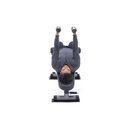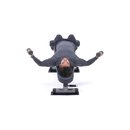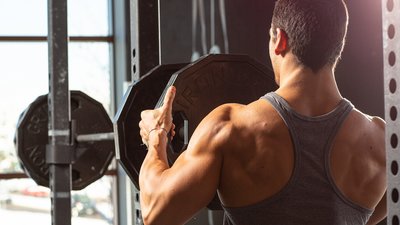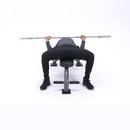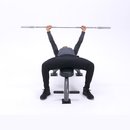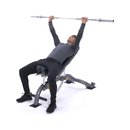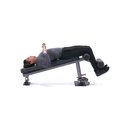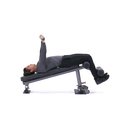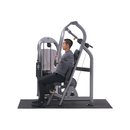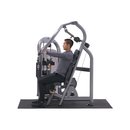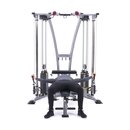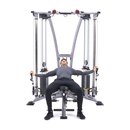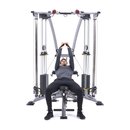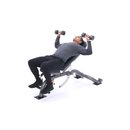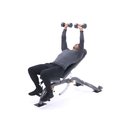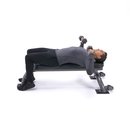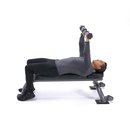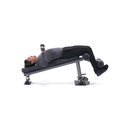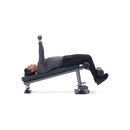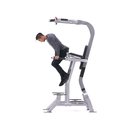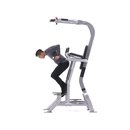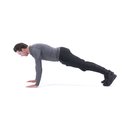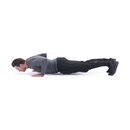As I began writing this article, NASA's Scott Kelly had just arrived back to Earth after spending a year in space. Upon his return, doctor's discovered he'd undergone changes in bone mass, vision, hearing, and skin sensitivity, and he'd actually grown two inches taller since the last time he stepped foot on this planet.
Like Scott Kelly's newfound vertical gains, the inch your chest will gain from this session won't be permanent—at least not yet. But if you perform it once a month or so, which is about as often as I'd recommend the workout, it can definitely become permanent.
The catch, of course, is that this chest workout demands extraordinary effort on your part. In fact, it requires about seven hours to complete. So perhaps it's best left for one of your weekend days, when you can give it your full attention. If you've got the time, the drive, and the experience, then let's blast off!
Warning
This workout protocol is intended for advanced lifters only. The degree of muscle damage may be too severe for beginning-level bodybuilders and even many intermediates.
How You'll Grow
You'll hit your chest in the morning, take an extended lunch break, and then head back to the gym for the final session. In order to get your chest to stretch and grow, you have to hit it hard and heavy from as many angles as possible, and then you need to flush and pump those same fibers from all those angles as well. Both the intensity and volume are key!
The Gain-an-Inch program is meant to amplify your body's usual responses to training: the temporary pump you get when working muscles fill with fluids, the breakdown of muscle fiber, and the subsequent inflammation caused by the extraordinary muscle damage as a result of heavy lifting.
Lifting heavy weights like you do in the morning causes the muscle fibers to break down, and your body repairs or replaces damaged muscle fibers through a cellular process that causes the fibers to thicken and become stronger. It necessitates that muscle protein synthesis be greater than the rate of muscle protein breakdown, which is why nutrition is such an important part of the equation.
To achieve this end, the morning session consists of heavy work inside a power rack. The power rack is ideal, because it allows you to overload your chest with as much weight as possible at many angles while providing a level of safety that should prove invaluable.
After lunch, your brutal afternoon workout will produce an amazing muscle pump. This feeling is caused by fluid being drawn into the muscle cells, which causes swelling. The pump is linked to muscle growth by what exercise scientists call metabolic stress, which accumulates over the course of your workout and is especially effected by higher-rep sets.
Of course, there will also be more muscle damage! Following a grueling workout, the muscle gets inflamed, and that inflammation causes swelling and increased girth. That muscle damage and metabolic stress adds to the overall increase in chest size following your workout.
By the end, you'll be cooked. Don't be surprised if you need a few days off afterward.
Keeping It Safe
In the two weeks leading up to your mission, don't take any of your pec exercises to failure, and keep your chest workouts at a low-to-moderate intensity level. Then, when the date arrives, plan an entire day for this routine. In between the morning and afternoon sessions, rest for at least 90 minutes, and eat up to ignite recovery and fuel your efforts.
As the workout wears on, you'll become increasingly fatigued and have to adjust your working weights accordingly. At some point, the cumulative fatigue may be so severe that you have to lower the weight on every set of a given exercise. Seriously, don't be a tough guy with weight selection! You're already tough just for attempting this.
Throughout the workouts, rest two minutes between sets of multijoint exercises and 90 seconds on single-joint moves. However, take more rest between movements. You'll need it to get all this work done.
Because of the rare and extreme circumstances of this single-day chest attack, you won't want to regularly follow this style of training. As I mentioned earlier, once every 4-6 weeks is a nice way to keep pushing the outer limits of chest growth.
Fuel Requirements for Your Mission
You'll need to be completely fueled for this exhaustive workout, and that means starting well beforehand. As early as two weeks out but no later than seven days beforehand, start loading up specifically on creatine, carbohydrates, and water.
- Take 5 grams of creatine daily, preferably with fast-digesting carbs such as white bread, white rice, or Gatorade.
- Increase your daily carb intake to as high as 3 grams per pound of body weight. A 170-pound individual would shoot for up to 510 grams daily.
- Drink 1-2 gallons of fluids per day. You'll want to be well hydrated to help transport nutrients into the muscle cells.
- On the day of your workout, continually feed yourself with a constant intake of both slow- and fast-digesting carbs, whey protein, and water. Try to consume something every hour, having both protein and carbs to offer your muscles a continuous source of amino acids and long-lasting energy from carbohydrates.
- During your lunch break, consume about 35 grams of protein from a lean-protein food and about 70 grams of carbs from a fast-digesting source. A whole-food meal will likely still be in your gut during the afternoon session, so choose foods or supplements that are easily absorbed.
Morning Chest Workout
This workout should take 3-4 hours. Do all the listed exercises in a power rack with an adjustable bench. Set the safeties to the bottom of the range of motion for each exercise variation, which allows you to bail out if necessary.
Warm-up adequately before starting. Do as many warm-ups as you need, but know that they don't count toward your set targets—and never take warm-ups to muscle failure. As for loads, choose a weight that approaches muscle failure by the target rep. A 4RM load is a weight you can do for only 4 reps with good form and no more.
Afternoon Chest Workout
This workout should take about 2-3 hours. Remember, the goal of this session is to achieve the greatest possible pump in your pecs. Perform some manner of warm-up, but you may not need much, given the light loads and the workout you completed earlier.
As for loads, choose a weight that approaches muscle failure by the target rep. A 20RM load is a weight you can do for only 20 reps with good form and no more. Since you probably don't know offhand what that weight is, adjust the poundage on successive sets as necessary.
